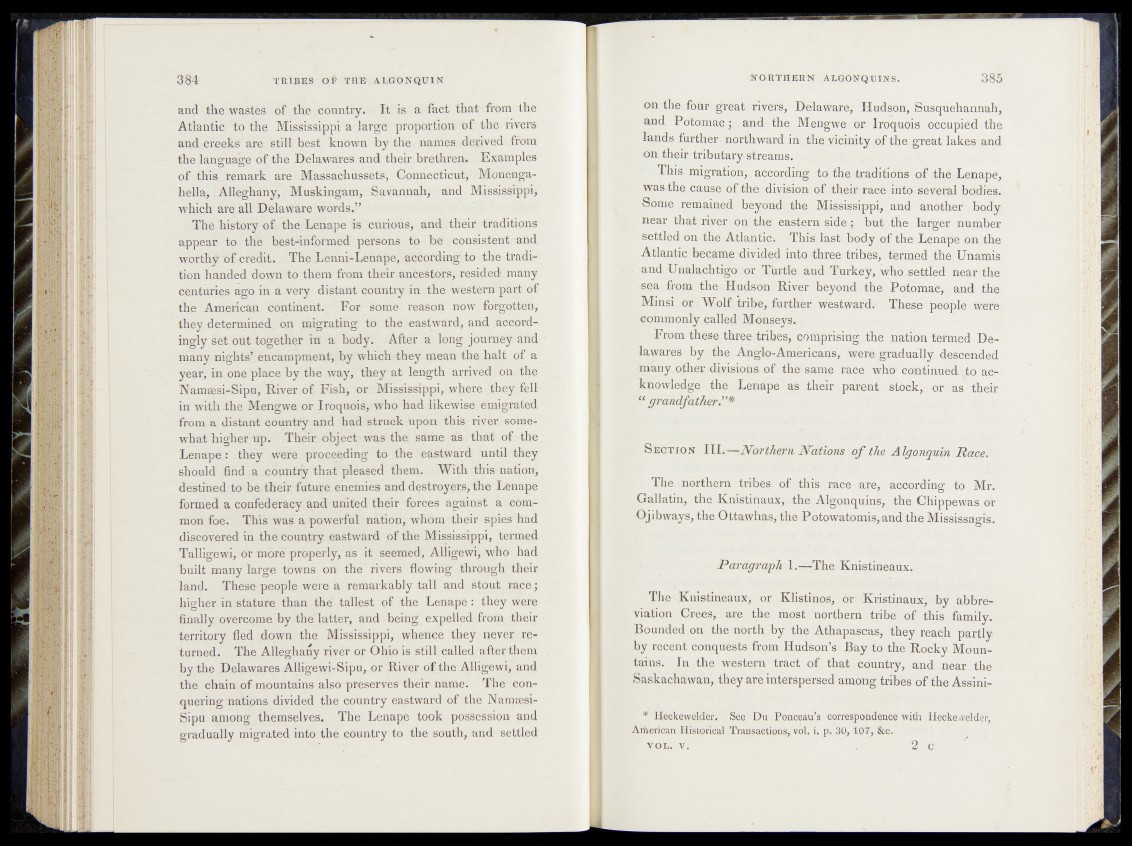
and tlie wastes of thie country. It is a fact that from the
Atlantic to the Mississippi a large proportion of the rivers
and creeks are stilfbest known by th e : names derived from
the language of the Delawares, and their brethren. Examples
of this remark are Massachussets, Connecticut, Monenga-
hella,; AHeghany, Muskingam, Savannah, and Mississippi;
which are all Delaware words.”
The history of. the Lenape is curious, and their traditions
appear to the best-informed persons to be' consistent'and
worthy of credit. The Lenni-Lenape, according to the tradition
handed down to them from their ancestors, resided* many
centuries ago in a very distant country in the western part of
the American continent. For some reason nöw forgotten,
they determined, on migrating to the eastward, and accordingly
set out together in a body. After a long journey rind
many nights’ encampment, by which they mean the halt of a
year, in one place by the way, they at length arrived on the
Namaesi-Sipu, River of Fish, or Mississippi, where they fell
in with .the Mengwe or Iroquois, who had likewise emigrated
from a distant country and had struck upon this river somewhat
higher up. Their object was the same as that of the
Lenape: they were proceeding to the eastward until they
should find a.country that pleased them. With this nation,
destined to be their future enemies and destroyers, the Lenape
formed a confederacy and united their forces against a common
foe. This was a powerful nation, whom their spies had
discovered in the country eastward of the Mississippi, termed
Talligewi, Or more’ properly, as it seemed, Alligewi, who had
built many large towns on the rivers flowittg through their
land. These people were a remarkably tall and stout race;
higher in stature than thé tallest of the Lenape: they were
finally overcome by the latter, and being expelled from their
territory fled down the Mississippi, whence they never returned.
The Alleghany river or Ohio is still called after them
by the Delawares Alligewi-Sipu, or River of the Alligewi, and
the chain of mountains also preserves their name. The conquering
nations divided the country eastward of the Nam-sesi-
Sipu among themselyes. The Lenape took possession and
gradually migrated into the country to the south, and settled
on the four great rivers, Delaware, Hudson, Susquehannah,
and Potomac; and the Mengweubr Iroquois-occupied the
lands further northward in the vicinity^of the great lakes and
on their tributary-streams. ,
This migration,.according to the traditions of thé Lenape,
wasthe^cau'se of the di.vtsipmo%their rac£>irito several bodies.
Some remained beyond the Mississippi, and another body
near that river on the eastern s id e -. buiv^fie-sferger- number
.settled on the Atlantic. This last body of the Lenape on the
Atlantic became divided into three tribes, - termed thé,U-namis
and Unalachtigo or Turtle and Turkey, who settled near the
•sea from the Hudson River beyopd the Potomac, and the
Minsi or Wolf tribe, further westward. These-1 people were
commonly called Mónseys, ;
From thèse three tribes, comprising the nation teamed Delawares
by ,-the Anglo-Americans'* weie- gradu^Ly-.descended
many other divisions of the same race who’ continuedito!acknowledge
the Lenape as their parents .stock,* or as their
“grandfather.”* :
Section I I I .—Northern Mations of. the A Igönquin Race.
The northern tribes of this race are; “accord^ng^to Mr.
Gallatin, the Knistinaux, the Algonquifik,! ;^ÀGhippeWas or
Ojibways, the Ottawhas, the Potowatomis, andihe Mississagis.
Paragraph 1 .—The Knistineaux.
The Knistineaux, or Klistinos, or Kristinaux, by abbreviation
Créés, are the most northern tribe of this family.
Bounded on the north by the Athapas'cas, they reach partly
by recent conquests from Hudson’s Bayitothe Rocky Mountains.
In the western tract of, that country, and near the*:
Saskachawàn, they are interspersed among tribes of the Assini